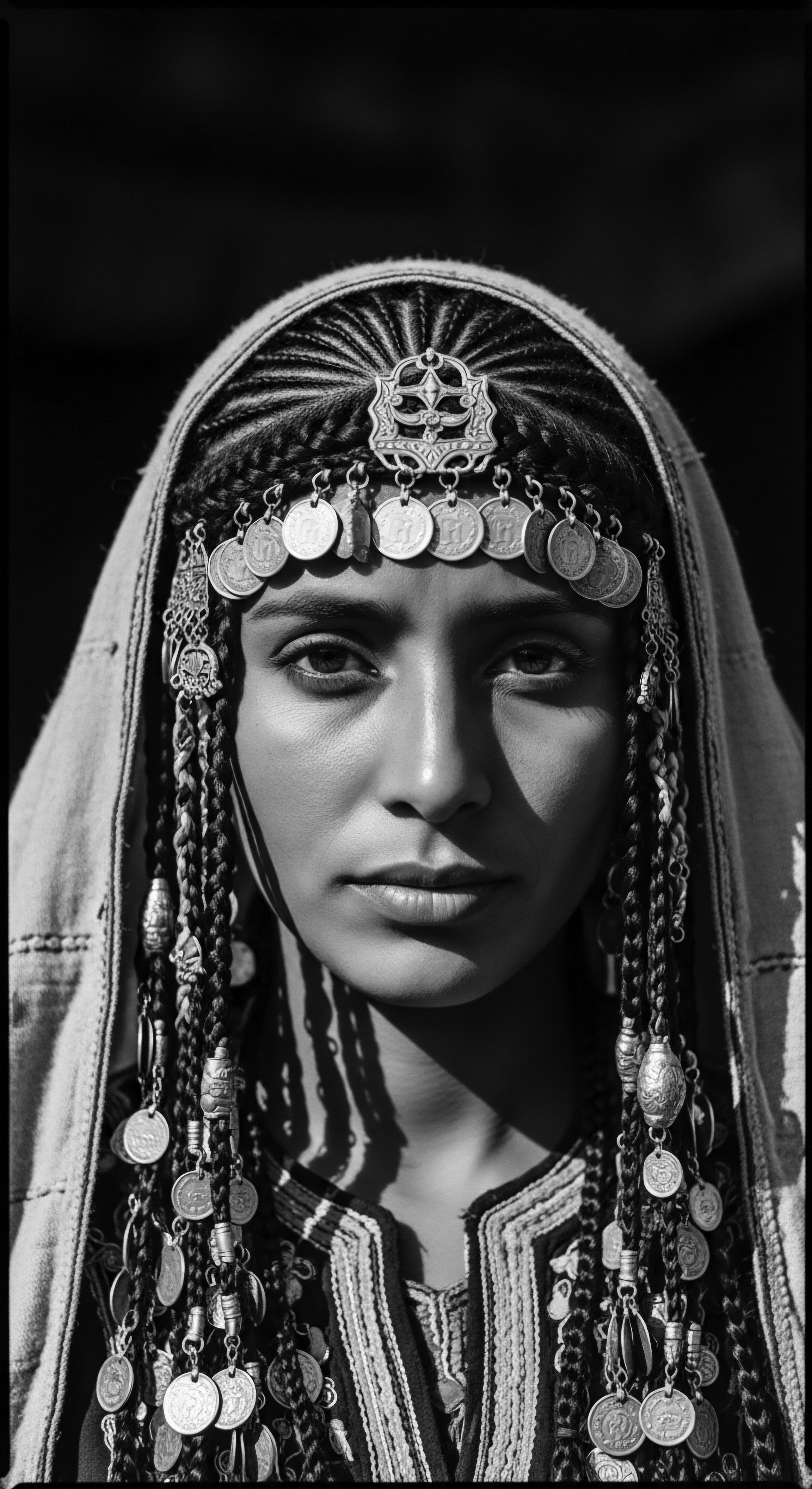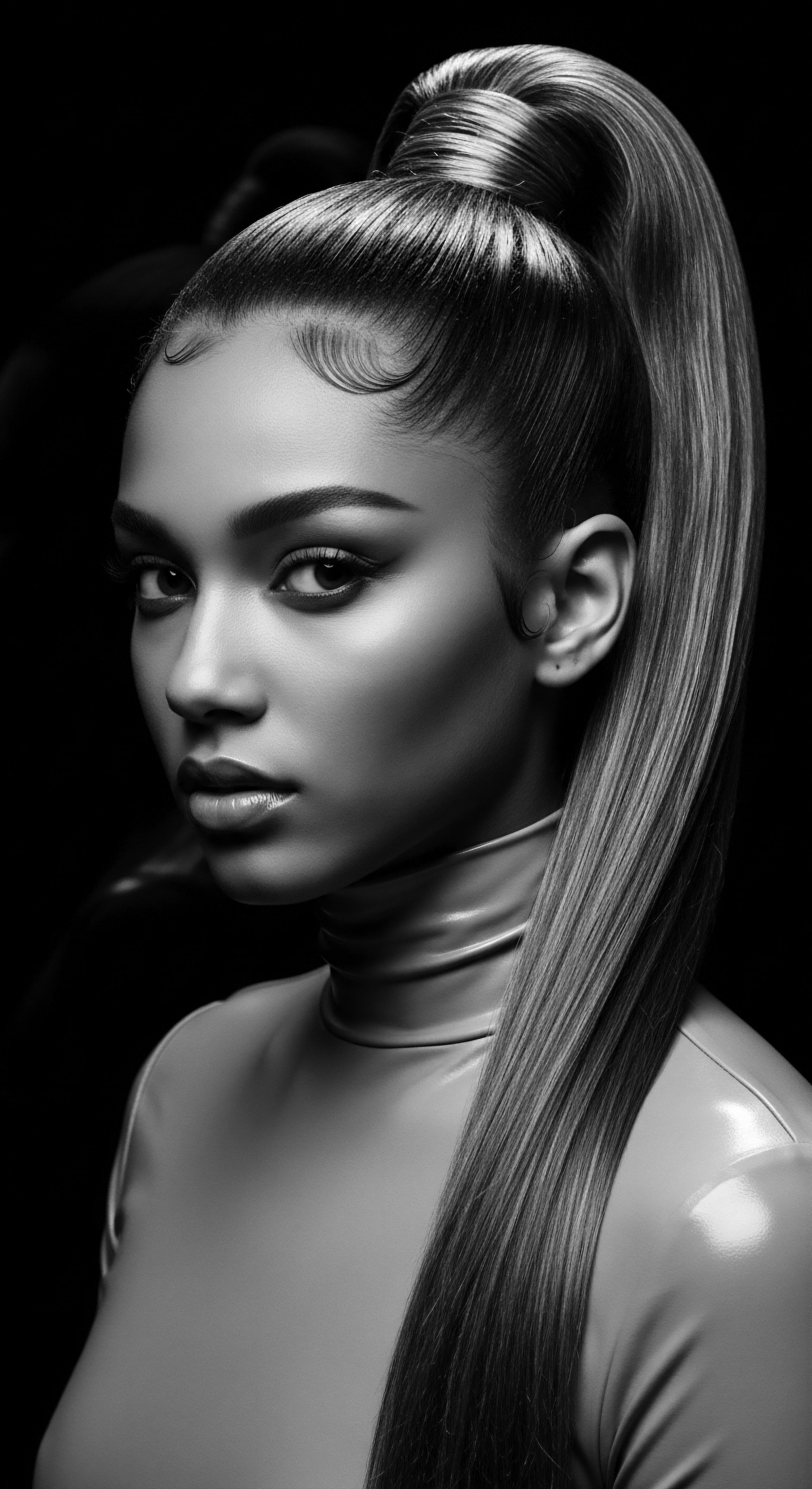
Roots
Across generations, from sun-kissed savannas to the vibrant shores of distant lands, the story of textured hair has unfolded as a living testament to heritage. It speaks of resilience, of beauty etched in every coil and curl, a language whispered from ancestral spirits to the very fiber of a strand. For those with high porosity textured hair, this whisper often carries a particular resonance, a quiet yearning for deep, sustained nourishment. It is hair that, in its very structure, welcomes moisture with open cuticles, much like an eager embrace, yet sometimes struggles to hold onto that blessing.
To truly comprehend the needs of high porosity hair is to listen to the echoes from the source itself. Before modern laboratories and their intricate molecular maps, our ancestors understood the hair’s relationship with its environment. They observed, they experimented, and through generations of careful practice, they discerned which gifts from the earth would offer protection and strength to hair that thirsted for substance. Their wisdom, passed down through touch and ritual, laid the groundwork for what we now understand as conditioning.

The Ancestral Understanding of Hair’s Openness
While the specific term “high porosity” is a relatively recent scientific classification, the observable qualities it describes were not lost on those who lived intimately with their textured crowns. They recognized hair that felt dry quickly after washing, strands that soaked up oils with ease, yet often appeared parched again by day’s end. This hair, with its naturally lifted outer layer, invited in elements – water, herbs, and butters – like a porous vessel. The challenge, then, was not merely introducing moisture but sealing it within, creating a lasting shield.
This ancient understanding gave rise to practices aimed at deeply saturating and protecting the hair. Imagine, for instance, the ceremonial application of rich butters and oils, not simply for adornment but for their profound effect on the hair’s very capacity to hold life. These were not just beauty treatments; they were acts of care, preserving the hair’s integrity in often challenging climates.

How Did Ancient Practices Address Hair’s Moisture Release?
Ancestral knowledge consistently pointed towards ingredients that would soften the hair, yes, but more importantly, create a lasting barrier against moisture loss. These practices often involved layers of application, beginning with water or a water-based infusion, followed by a heavier, more occlusive agent. The intuitive science behind this layering mirrors our modern understanding of how to manage high porosity hair effectively. It was about creating a sustained presence of moisture.
Ancestral wisdom recognized high porosity hair’s inherent thirst and sought ingredients that offered both absorption and lasting protection.
The traditional ingredients that emerged as staples for conditioning hair, particularly strands that readily absorbed and just as quickly released moisture, are often those rich in fatty acids, humectants, and natural emollients. These botanical allies were plentiful in their native landscapes and became integral to the daily and weekly hair rituals of communities.
Consider the use of plant-based materials and how they might have been categorized by early practitioners based on their tactile effects.
| Observed Hair Quality Quickly Absorbs, Quickly Dries |
| Traditional Ingredient Class Rich Oils and Butters |
| Ancestral Benefit for Hair Seals moisture, adds weight and sheen. |
| Observed Hair Quality Brittle, Prone to Breaks |
| Traditional Ingredient Class Strengthening Herbs |
| Ancestral Benefit for Hair Fortifies strands, reduces fragility. |
| Observed Hair Quality Rough Texture |
| Traditional Ingredient Class Slippery Mucilages |
| Ancestral Benefit for Hair Smooths cuticle, aids detangling. |
| Observed Hair Quality Understanding these inherent traits allowed for a heritage of targeted and effective hair care. |

Ritual
The conditioning of high porosity textured hair was not simply a mundane task; it was often interwoven with ritual, a sacred act performed with intention and often within the communal embrace of family. These rituals, whether daily preparations or weekly deep treatments, transcended mere hygiene, becoming moments of connection to self, to kin, and to the earth. The ingredients chosen were not random; they were part of a learned inheritance, each valued for its specific contribution to the hair’s well-being.
The act of applying these traditional ingredients became a tender thread linking generations. Grandmothers taught daughters, and mothers taught children, the precise way to warm an oil or steep an herb, explaining its particular power to soften, strengthen, or protect the hair. For high porosity hair, which demanded consistent attention, these routines ensured the strands remained pliable and vibrant, less prone to the dryness and fragility that could otherwise mar their beauty.

The Ceremonial Application of Botanical Treasures
Take, for instance, the prominence of Shea Butter. Originating from the karite tree of West Africa, its use spans centuries, a testament to its protective and conditioning prowess. Women would gather the nuts, process them into the golden, creamy butter, and use it generously on both skin and hair. For high porosity hair, shea butter acted as a potent sealant, its rich fatty acid profile helping to close the cuticles and lock in the moisture that the hair so eagerly absorbed.
It was not merely an ingredient; it was an economic cornerstone, a cultural artifact, and a balm for resilience. Its traditional application involved warming a small amount between the palms, allowing it to liquefy before being worked through the damp strands, often after a water rinse or an herbal wash. This practice ensured maximum absorption and a lasting occlusive layer.
Another ancestral staple, particularly across the Caribbean and parts of Africa, is Castor Oil. While many variations exist, Jamaican Black Castor Oil (JBCO), distinguished by the roasting of the castor beans before pressing, carries a particular cultural weight. Its thick consistency and unique processing made it a prized ingredient for those seeking to condition and fortify hair.
For high porosity strands, JBCO’s humectant properties, drawing moisture from the air, combined with its viscous nature, created a strong protective barrier, preventing the rapid evaporation of water that is characteristic of this hair type. Generations have relied on it, not just for perceived growth benefits but for its undeniable ability to lend a substantial, conditioned feel to the hair.

How Did Community Shape Hair Care with Natural Ingredients?
Hair care in many traditional communities was a collective endeavor, far removed from the solitary rituals of today. It was a time for storytelling, for bonding, for sharing the lore of the plants and the wisdom of their preparation. The communal application of ingredients for conditioning, particularly for children, reinforced the values of care, connection, and the passing of cultural knowledge. These shared moments meant that the techniques for handling high porosity hair – gentle detangling, slow and deliberate application of butters, the art of braiding for protection – were not abstract concepts but lived experiences, transmitted through observation and guided touch.
Hair care in ancestral traditions was often a communal ritual, weaving together self-care with shared wisdom and familial bonds.
The Yao Women of Huangluo Village in China offer a compelling, globally recognized illustration of how traditional ingredients, consistently applied through ritual, yield extraordinary hair health. Their centuries-old practice of using Fermented Rice Water to wash and condition their hair is a testament to the efficacy of ancestral wisdom. The Yao women, renowned for their hair often reaching six feet in length, demonstrate a profound connection between their identity and their hair care rituals. Fermented rice water, rich in vitamins, antioxidants, and inositol, a carbohydrate that can remain in the hair even after rinsing, effectively strengthens the hair shaft, reduces friction, and boosts elasticity.
For high porosity hair, this natural protein-rich treatment helps to temporarily patch gaps in the cuticle, providing a conditioning and fortifying effect that reduces moisture loss and enhances overall strand integrity (Chua, 2017). This practice is not just about length; it is about maintaining incredible resilience and sheen, qualities that are particularly difficult to sustain in high porosity hair without targeted conditioning.
Other ingredients found their place in these heritage rituals, each contributing to the holistic conditioning of textured hair ❉
- Coconut Oil ❉ Used across tropical regions, especially in parts of Asia, Africa, and the Caribbean. Its unique molecular structure allows it to penetrate the hair shaft, reducing protein loss, a vital benefit for high porosity hair that can be prone to protein depletion.
- Aloe Vera ❉ Valued for its mucilaginous properties, providing slip and moisture. Its use is historical across various cultures, including those in Africa and the Middle East, for both skin and hair. For high porosity hair, it offers a hydrating layer that smooths the cuticle.
- Honey ❉ A natural humectant used in many traditions. When diluted and applied, it draws moisture from the air into the hair, a beneficial action for high porosity strands that crave hydration.
- Amla (Indian Gooseberry) ❉ A staple in Ayurvedic hair care. Its high vitamin C content and antioxidant properties contribute to scalp health and hair strength, indirectly aiding in the better retention of conditioning benefits for high porosity hair.
These ingredients, often combined or layered, formed the backbone of conditioning routines that intuitively addressed the specific needs of hair that freely absorbed and released moisture. The tradition was not merely about application; it was about the art of listening to the hair, understanding its subtle shifts, and responding with the earth’s bounty.

Relay
The wisdom of our forebears, those astute observers of nature and hair, laid down a foundational understanding that continues to resonate with modern scientific inquiry. The insights they gathered through generations of lived experience, passed down as heritage, now find validation in the language of molecules and cuticles. When we speak of traditional ingredients conditioning high porosity textured hair, we are bridging vast spans of time, connecting ancestral ingenuity with contemporary biochemical understanding. This relay of knowledge, from ancient practice to current science, underscores the enduring efficacy of these natural gifts.
High porosity hair, characterized by its lifted cuticles, functions much like an open door. It allows moisture to enter swiftly, but also permits its escape with equal ease. This inherent characteristic means the hair craves ingredients that can not only infuse it with hydration but, more critically, create a protective barrier that seals that moisture within. Ancestral practices consistently selected ingredients that excelled at this dual function, intuitively understanding the hair’s need for both saturation and enclosure.

How Do Traditional Ingredients Interact with Hair’s Porosity?
The natural world offers a sophisticated array of compounds that address the challenges of high porosity hair. Many of the oils and butters employed by our ancestors are rich in saturated and monounsaturated fatty acids. These particular fatty acids possess a molecular structure that allows them to penetrate the outer cuticle layer of the hair shaft, or at least to sit effectively upon it, creating a protective film. This is a critical distinction for high porosity hair, where larger molecules might simply sit on the surface, offering temporary gloss but little lasting conditioning.
Consider the molecular dance. When oils like Coconut Oil are applied, their smaller molecular weight and linear structure enable them to actually pass beyond the cuticle and enter the cortex. This internal conditioning helps to reduce the rate of protein loss during washing, a particular vulnerability for high porosity hair.
Coconut oil’s ability to penetrate the hair shaft means it offers more than just a surface seal; it provides a deeper, more substantial form of conditioning that fortifies the strand from within (Rele & Mohile, 2003). Similarly, the consistent use of Olive Oil, rich in oleic acid, provides excellent emollient properties, coating the hair shaft and smoothing down the cuticles, thereby minimizing moisture evaporation.

The Resilience of Ancestral Practices in Modern Application
The persistence of these traditional ingredients in contemporary hair care, especially within Black and mixed-race communities, speaks volumes to their proven effectiveness. Despite the advent of synthetic compounds and complex formulations, the simple power of nature’s bounty remains a cornerstone. This enduring presence is not mere nostalgia; it is a testament to observable results, validated by both lived experience and scientific analysis.
The enduring use of traditional ingredients in hair care is a powerful testament to their historical effectiveness and modern scientific validation.
The journey of certain traditional ingredients across continents, carried by people, speaks to a different kind of relay – the preservation of culture through adaptation. The Shea Butter tree did not grow in the Americas, yet its use was adapted and cherished by diasporic communities, who either found substitutes or, through trade, continued to access this vital resource. This adaptation shows the incredible ingenuity in preserving heritage, finding new ways to apply ancestral wisdom in new lands and with new, often challenging, resources. This historical continuity in hair care practices, despite immense disruption, highlights the profound importance of hair as a marker of identity and resilience.
Let us delve deeper into how specific traditional components address the distinct architecture of high porosity hair ❉
- Occlusive Agents (Butters and Heavier Oils) ❉ Ingredients such as Shea Butter, Mango Butter, and Castor Oil function as effective occlusives. They form a protective film on the hair surface, sealing the lifted cuticles and preventing the rapid loss of water. Their richness provides a substantial barrier, crucial for hair that struggles with moisture retention. The traditional practice of applying these after moisturizing the hair with water or a lighter liquid exemplifies an intuitive understanding of sealing.
- Penetrating Oils ❉ Beyond surface sealing, certain oils offer a deeper conditioning. Coconut Oil and Avocado Oil, with their smaller, more appropriate molecular structures, can traverse the cuticle, integrating with the hair’s lipid layers and reducing internal moisture loss. This directly combats the inherent vulnerability of high porosity strands.
- Humectants and Emollients from Plants ❉ Natural humectants like raw Honey, when diluted, draw moisture from the environment into the hair, keeping it hydrated. Emollient plants like Aloe Vera and mucilage-rich herbs (such as slippery elm or marshmallow root) provide slip and a smoothing effect, helping to lay down the cuticles and reduce friction, which can lead to further damage in high porosity hair.
- Protein-Rich Botanicals ❉ While direct protein treatments are often associated with strengthening, some traditional ingredients provide mild protein support. For instance, the fermented rice water used by the Yao women, contains traces of amino acids and inositol, which adhere to the hair and contribute to its structural integrity, temporarily filling gaps in the compromised cuticle of high porosity strands. This helps to reinforce the hair and reduce breakage. (Chua, 2017).
The efficacy of these ingredients, cultivated through generations of ancestral experience, now stands as a beacon of natural care for high porosity hair. It is a powerful reminder that the past holds keys to our present well-being, particularly for the unique journey of textured hair.
| Traditional Ingredient Coconut Oil |
| Primary Conditioning Mechanism Penetrates cortex, reduces protein loss. |
| Benefit for High Porosity Hair Internal strength, reduces moisture evaporation. |
| Traditional Ingredient Shea Butter |
| Primary Conditioning Mechanism Forms occlusive barrier on hair surface. |
| Benefit for High Porosity Hair Seals moisture, reduces environmental damage. |
| Traditional Ingredient Castor Oil |
| Primary Conditioning Mechanism Viscous humectant, thick coating. |
| Benefit for High Porosity Hair Draws moisture, provides durable protective film. |
| Traditional Ingredient Aloe Vera |
| Primary Conditioning Mechanism Mucilaginous, emollient, hydrating. |
| Benefit for High Porosity Hair Smooths cuticles, provides slip, attracts moisture. |
| Traditional Ingredient Fermented Rice Water |
| Primary Conditioning Mechanism Inositol adherence, mild protein/amino acids. |
| Benefit for High Porosity Hair Temporarily patches cuticle, strengthens, reduces friction. |
| Traditional Ingredient These traditional gifts from the earth offer targeted solutions, bridging ancestral practice with modern scientific understanding. |

Reflection
The journey through the conditioning of high porosity textured hair, guided by the ancestral hands that first worked with earth’s gifts, brings us to a poignant reflection. The “Soul of a Strand” is not an abstract concept; it is a tangible connection to generations past, a living archive inscribed in every curl and coil. The ingredients our forebears chose, and the rituals they meticulously performed, were not born of happenstance. They were a testament to deep observation, profound intuition, and an unwavering respect for the hair as a sacred extension of identity and heritage.
For high porosity hair, a hair type that speaks of an openness, an eagerness to receive yet also a vulnerability to lose, these traditional conditioning ingredients offer more than mere cosmetic benefit. They represent a legacy of resilience. The careful application of a rich butter, the patient steeping of an herb, the gentle anointing with an oil – each act carries the weight of a history where self-care was intertwined with survival and cultural preservation. These practices, honed over centuries, empowered communities to maintain the health and beauty of their hair, even in the face of immense challenges and displacement.
Our modern understanding of hair science often validates the efficacy of these time-honored methods. The very molecular structures that we dissect in laboratories echo the tactile wisdom of a great-grandmother preparing her remedies. This convergence of ancient wisdom and contemporary knowledge invites us to approach our hair not as a problem to be solved with the latest chemical solution, but as an ancient text to be read, honored, and tended with the same reverence our ancestors employed. The path to truly radiant, healthy high porosity hair, therefore, is often a homecoming – a return to the natural gifts that have always been available, waiting patiently for our rediscovery.

References
- Chua, J. H. (2017). Hair Strengthening Effect of Fermented Rice Water. International Journal of Trichology, 9(3), 114-118.
- Rele, J. S. & Mohile, R. B. (2003). Effect of Mineral Oil, Sunflower Oil, and Coconut Oil on Prevention of Hair Damage. Journal of Cosmetic Science, 54(2), 175-192.
- Adjanohoun, E. J. & Ake Assi, L. (1991). Contribution to Ethnobotanical Studies in West Africa ❉ The Case of Côte d’Ivoire. Agence de Coopération Culturelle et Technique.
- Oyelade, O. J. et al. (2009). Proximate Composition and Mineral Content of Castor Seed (Ricinus Communis) Grown in Different Locations in Nigeria. International Journal of Agriculture and Biology, 11(2), 223-225.
- Sharma, S. & Singh, A. (2018). Herbal Cosmetics and Ayurvedic Preparations. CBS Publishers & Distributors.
